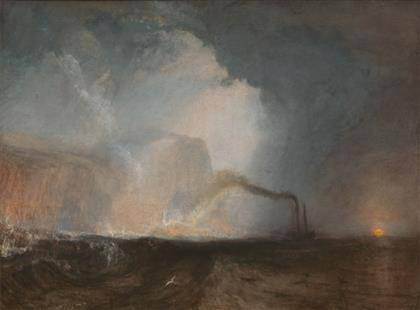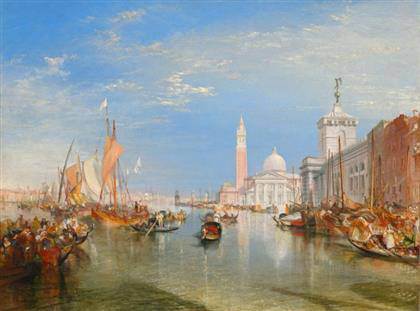
Joseph Mallord William Turner
Staffa, Fingal’s Cave (1831-32)
Yale Center for British Art, Paul Mellon Collection.

Joseph Mallord William Turner
Venice: The Dogana and San Giorgio Maggiore (1834)
National Gallery of Art, Washington, D.C. Widener Collection.
Turner & the Sea – Peabody Essex Museum The Peabody Essex Museum (PEM) presents ‘Turner & the Sea’, the largest US exhibition of Joseph Mallord William Turner’s maritime paintings. On view May 31 to September 1, 2014.]]>
Source: Peabody Essex Museum
“Turner & the Sea” features more than 100 works spanning the fifty-year career of one of Britain’s celebrated painters. Encompassing oils, watercolors, prints and sketches from the 1790s to the mid-1800s, this first full-scale examination of Turner’s lifelong attraction to the sea follows the artist’s evolution from precocious young painter to one of the most important, controversial and prolific masters of his art. Dramatic and roiling, sunlit and cloudstruck, the power of Turner’s glorious canvases changed the maritime aesthetic and influenced countless painters hundreds of years after his time.
Turner painted the sea more often than any other subject, and it was central to his artistic vision from his earliest, career-establishing works right to the very end of his productive life. The sea in itself would provide endless pictorial inspiration with its physical characteristics and inherent poetry. The infinitely mutable nature of water and its relationship with light would offer everlasting interest and challenge to any painter. Combined with the sociopolitical realities of Turner’s surroundings, there was no escaping the magnetism of the sea as subject matter. In Turner’s time, Britain was engaged in decades of naval conflict and life on the open seas was very much in the public imagination.
Turner & the Sea is organized in seven thematic sections: “Turner on Show” features “Fishermen at Sea”, the first oil painting Turner exhibited at the Royal Academy in 1796. “Charted Waters” shows how the tradition of marine painting served as a benchmark against which Turner’s early artistic efforts were judged. “‘M’ for Marine” includes works on paper, such as his collection of prints called the “Liber Studiorum” or “Book of Studies”. “Contested Waters” shows how Turner developed a new approach to epic history painting. “Imagining the Sea” exhibits drawings and watercolors. “Making Waves” is devoted to Turner’s final seascapes, unbound by the established rules and conventions of maritime art. The last section of the exhibition, “Atlantic Crossings”, shows Turner’s influence on later American painters.
Related content
Turner and the Sea at the National Maritime Museum, Greenwich (exhibition, 2013)
Follow us on:


